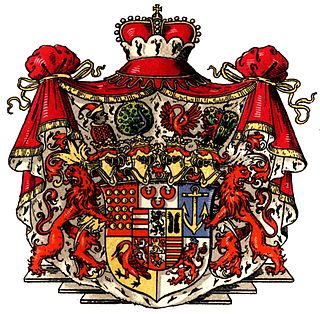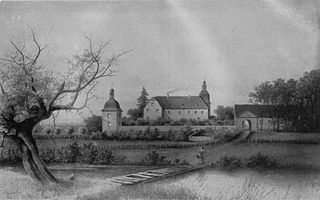
The County of Mark was a county and state of the Holy Roman Empire in the Lower Rhenish–Westphalian Circle. It lay on both sides of the Ruhr River along the Volme and Lenne rivers.

Bentheim-Tecklenburg was a German county based in the region around Tecklenburg in northern North Rhine-Westphalia, Germany.

Limburg-Hohenlimburg was a county in Germany in the Middle Ages. It was created as a partition of Limburg-Isenberg by Diederck I of Isenberg, who called himself in 1246 Diederick I van Limburg. Of Diederick's two sons, the eldest son Johan who died in 1277 at the adge of thirty and left two sons and one daughter. He is the ancestor of the lordship Styrum. His youger brother Everhard continued 30 years more, the struggle with his father for the conquest of former Isenberger family property. Everhard, in 1301 the 'nearest in the bloodline', succeeded his father.

Count Frederick of Isenberg was a German noble, the younger son of Arnold of Altena. Before the split between Arnold of Altena-Isenberg the eldest and his brother Friedrich Altena-Mark the younger son of Everhard von Berg-Altena. His family castle was the Isenberg near Hattingen, Germany.

Hagen-Hohenlimburg, on the Lenne river, is a borough of the city of Hagen in North Rhine-Westphalia, Germany.

Styrum was an immediate lordship in the Holy Roman Empire, located in Mülheim an der Ruhr, North Rhine-Westphalia, Germany. It held no seat in the Diet and was circumvened by the Lordship of Broich.

The House of Limburg-Stirum, which adopted its name in the 12th century from the immediate county of Limburg an der Lenne in what is now Germany, is one of the oldest families in Europe. It is the eldest and only surviving branch of the House of Berg, which was among the most powerful dynasties in the region of the lower Rhine during the Middle Ages. Some historians link them to an even older dynasty, the Ezzonen, going back to the 9th century.
William of Limburg-Broich was the Count of Limburg-Broich from 1446 until 1473.
Wirich VI, Count of Daun-Falkenstein was a German nobleman, diplomat, statesman, and politician. By descent, he was a Count of Falkenstein, and by inheritance, he was Lord of Broich and Lord of Bürgel. He belonged to the lower nobility in the Duchy of Berg and was a member of the Estates of Berg. He supported the Reformation in the Lower Rhine area.
Gumprecht II of Neuenahr was a German nobleman. He inherited the County of Limburg via his wife.
Magdalena of Neuenahr-Alpen was a German noblewoman. She was the heiress of the House of Neuenahr-Alpen; she inherited the County of Limburg. By marriage, she was Countess of Tecklenburg.

The house of Limburg Hohenlimburg took its name in the 12th century from the county of Limburg on the river Lenne in today's Germany. After Diederick of Isenberg had claimed part of the former property of his father Frederik of Isenberg with the help of uncle Duke Hendrik of Limburg, he built the Hohenlimburg castle on the river Lenne. His youngest son Everhart succeeded him in the county at the end of the 13th century and is the ancestor of the family branch of the counts of Limburg Hohenlimburg and Broich. His eldest brother Johan (1247-1277), died at the age of thirty, left three children. The Counts of Limburg Hohenlimburg and Broich were not only a count by name (title), but actually ruled the county of Limburg-Lenne until the first quarter of the 16th century. The last count Johan (1464-1511) who had no descendants of his own. None of his only two male relatives, cousins Diederick and Adolf of Limburg, sons of his former godfather Johan of Limburg (1421-1472), had inheritance rights, as explained below. To prevent the family of his former wife Von Neuenahr from taking the county, Count Johan adopted his cousin Irmgard of Sayn at her marriage to Winrich of Daun. She and her husband inherited the county.

Diederik II Count of Limburg Hohenlimburg was a son of Everhard I and Agnes.

Everhard II Knight of Limburg Hohenlimburg (1298 - 11 November 1344) was the eldest son of Diederik II count of Limburg Hohenlimburg and Irmgard of Greifenstein, intended as a successor. Together with his brothers Kraft and Diederik, they have been mentioned in their father's charters since 1324. But due to his pre-death, Everhard did not manage the county of Limburg independently as count. Around 1326 he married Jutta of Sayn, daughter of Engelbrecht II, Count of Sayn Homburg. They had two sons Diederik and Johan. Their great-uncles Hendrik and Diederik had previously died without descendants, while his uncle Kraft was canon of the Abbey of Essen. That is why the brothers would become direct heir to their grandfather in 1364. Uncle Kraft, then co-regent and guardian of his cousins, took care of the transfer of the county.

Diederik III of Limburg Hohenlimburg, born around 1328, was the eldest son of Everhard II van Limburg Hohenlimburg and Juta of Sayn. Twenty years later he followed the 9th of August 1364 his grandfather Diederik II count of Limburg Hohenlimburg. In 1366 Diederik III became the Amtmann of Angermünde, the district between Duisburg and Düsseldorf. As the successor to lord Diederik III of Broich, who five years later would become his father-in-law. He also was Voght of the Rellinghausen Abbey. On 3 July 1371 Diederik married Ludgardis (Lukarda) daughter of Diederik of Broich and Katharina of Steinfurt. Lukarda was heiress of the Lordship Broich. At his wedding, he received a dowry of 1,600 old gold shields.

Engelbert of Altena-Isenberg was appointed Propst at St. George's Church in Cologne around 1220 and then Dompropst von Osnabrück in 1222. On September 4, 1223 Engelbertus, Osnabrugensis ecclesie maior prepositus he became Engelbert I bishop of the Prince-Bishopric of Osnabrück. and reigned during two periods, the first from 1224 - 1226 and the second from 1237 - 1250.

Bruno of Altena-Isenberg, known as Bruno of Isenberg, was Prince-Bishop of Osnabrück from 1250 to his death. He succeeded his brother Engelbert III as Prince-Bishop.

Dietrich IV of Limburg Hohenlimburg, born around 1375, was the second son Diederik III count of Limburg Hohenlimburg and Broich and Lukardis of Broich. He had an older sister Elisabeth and brother Willem I. Elisabeth married Dietrich IV of Volmestein. Willem married Metza of Reifferscheidt Erbin of Bedburg. Dietrich IV married Henrica of Wisch on 3 February 1415. Her father bannerlord Hendrik of Wisch and mother Elisabeth of Bronkhorst belonged to the most important nobility in Gelre. The bannerlords of Wisch had their castle Wisch on the old IJssel near Terborg.. Henrica had one younger sister Elisabeth married to Johan of Volmarstein. This created a double family ties between the Lower Rhine families Of Limburg, Of Volmarstein and the Gueldrian Of Wisch.

The brothers counts Willem II and Hendrik I, sons of Diederick IV count of Limburg Hohenlimburg Broich and Lukardis of Broich succeed each other as Count of Limburg Hohenlimburg Broich. In 1446, two years after the death of their father Diederick. The Archbishop of Cologne, after the conquest of Broich castle handed over his share of Broich to Willem II of Limburg. The Duke of Gullick-Berg also returned his share of Broich. Willem had to reconfirm provisions that his father Diederik IV had agreed upon in 1430. Brother Hendrik of Limburg continued to fight for the Cleves party. It was not until April 7, 1454, that he agreed to waiver of his Lordship rights to Broich.